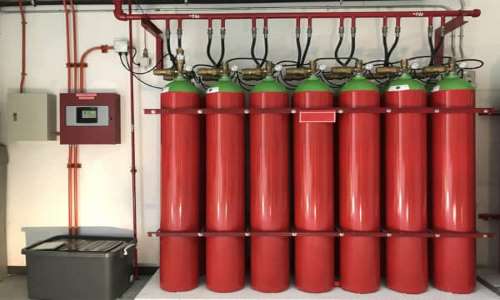The Benefits of Nitrogen Fire Protection
 By
By
Nitrogen gas exists naturally in the environment and is safe to be around, acting as a fire suppressant by depriving flames of oxygen. Nitrogen generators create pure nitrogen on-site to be added directly into your sprinkler system, eliminating extra molecules found in air (made up of 78% nitrogen, 21% oxygen, argon and small traces of water). Corrosion reduction lowers maintenance costs while increasing your system's life expectancy. The Kidde Argonite system is an innovative nitrogen generator that uses air as the Argon source for fire suppression. Reduced Corrosion Nitrogen generator systems installed into fire sprinkler systems remove oxygen from the system piping, slowing corrosion rates and lengthening its overall lifespan. Plus, using nitrogen rather than air for the piping allows your organization to save money by opting for black steel pipes rather than galvanized pipes - saving both on costs as well as time when replacing or maintaining. Corrosion of piping is one of the leading reasons fire protection systems fail, preventing sprinklers from spraying water during an emergency. One solution to this issue is inerting all piping with pure nitrogen; this prevents build-ups of rust, clogs and channel obstructions which allow oxygen into piping leading to corrosion process and ultimately fire suppression system failure. Unfortunately this risk exists in industrial and commercial settings alike where fire suppression system are vital to operational safety; with pure nitrogen generator systems this risk can be eliminated permanently. Faster Response Time Nitrogen fire protection can be an ideal addition to an existing fire sprinkler system in any building. Once integrated with it, on-site nitrogen generators can inert piping by reducing oxygen content in order to prevent rusting which could obstruct emergency channels in case of fire outbreak. Nitrogen provides an environmentally-friendly, people-safe way to extinguish fires compared to carbon dioxide which may damage and decompose materials and equipment in its process of extinguishing fires. Furthermore, nitrogen provides a safer solution in occupied spaces where people may be present as it ensures their safety as well. An additional advantage of installing a nitrogen system in your fire protection systems is how quickly they respond. Nitrogen systems displace oxygen much more rapidly than traditional air, giving firefighters enough time to evacuate quickly when an alarm goes off, potentially saving vital seconds that could save lives in an emergency situation. Lower Maintenance Costs Nitrogen generator systems for dry fire sprinklers can save up to 30% in upfront material costs, due to how the nitrogen generated replaces oxygen in pipes, inhibiting corrosion and prolonging their lifespan. Corrosion of steel pipes used in fire protection systems can result in the accumulation of rust that blocks water channels within a sprinkler head, rendering it incapable of dousing fires when necessary. South-Tek Systems offers customized systems featuring nitrogen generation systems which dispense pure nitrogen throughout sprinkler pipework to combat corrosion and ensure effective firefighting capabilities. This system employs a high-pressure air compressor to produce on-site nitrogen of 98% purity for use in your fire protection sprinkler system, eliminating the need for separate nitrogen storage tanks, air dryers, or extensive gas sample tubing. Thanks to patented technology, installation is straightforward with minimum annual maintenance needs resulting in reduced costs overall and seamless integration into both wet or dry fire sprinkler systems. Reduced Environmental Impact Addition of nitrogen systems can drastically decrease corrosion in a dry pipe system and extend their lifespan and save customers money on costly maintenance calls. Nitrogen gaseous fire suppression agents are among the greenest available and do not deplete ozone layer, making them exceptionally safe to use in areas with people present since there's no requirement for "sealing". Carbon dioxide systems require an enclosure in which to operate; nitrogen systems do not. Lan et al used liquid nitrogen to assess its effectiveness against an urban underground pipe gallery fire model. They observed that nitrogen-induced asphyxiation significantly reduces oxygen, leading to fire extinguishment. Temperature trends above flame sources under various nitrogen injection flows showed consistent declines at first, before speeding up once smaller pipe diameters were considered in testing.






